Neither Donald H. Layton, nor anyone other typical human that this writer has met or heard about, is able to see into the future with total clarity or certainty. That is to say that Layton’s first installment of a research article for the Furman Center, shared in Part I and unpacked with added facts, evidence, and analysis in Part II, could not have known some of the facts that will be presented herein that were published after his interesting article. Research data looks back. The lessons good research may have can then be applied to better understand the present and potentially prepare for the future.
We live in an era of increasing distrust and disappointment with U.S. institutions. Congress, much of the ‘mainstream’ or ‘mass’ media, politicians, and corporations routinely have more distrust than trust, according to surveys by Gallup or others. The view of this writer and publication is that by providing more details and the source for referenced items, readers can better discern what is reasonably accurate and what may be less accurate and possibly the product of some unstated agenda.
So, what follows is different than a traditional fisking or fact check in some ways will arguably provide several of the same benefits for readers. Consumers looking for affordable housing should benefit. So too can public officials, other researchers, mainstream media, or anyone interested in better understanding the mobile homes of the past (roughly 1950s to mid-1970s) which became the manufactured homes of today.
Every article, every research report, even a good book leaves out more potential information than is included. That said, what Layton didn’t mention in the following, per a WORD search of this article are the following. In no particular order of importance:
- There is no mention of the Manufactured Housing Improvement Act of 2000 (a.k.a.: MHIA 2000, MHIA, 2000 Reform Act, 2000 Reform Law) passed by widely bipartisan support and signed into law by then President William Jefferson “Bill” Clinton (D).
- There is no mention of preemption, federal preemption, or enhanced preemption by Layton.
- There is no mention of the Housing and Economic Recovery Act of 2008 (HERA), another widely bipartisan law that was signed into law by George W. Bush (R).
- There is no mention of the Duty to Serve Manufactured Housing made federal law by HERA.
Layton led Freddie Mac was the CEO of Freddie Mac from May 2012 until June 2019, according to a bio in brief by the Harvard Joint Center for Housing Studies.
The Enterprise Community Partners says about Layton’s career the following.
Former Chief Executive Officer, Freddie Mac; Former Vice Chairman, JPMorgan Chase. Donald H. Layton is an industry veteran with more than 40 years of experience in banking, financial services and housing finance.
Is Layton knowledgeable? Yes. Did he hit all of the key facts? He does reveal much, but missed several key facts too, as was noted in this preface and will be further examined in Part II.
With that backdrop, next let’s see what Layton said in his own words and pay attention to what sources he cited, and what he didn’t cite along with other insights found in Part II. Note his photo and an illustration of a basic single section manufactured home community are omitted below but are included in the featured image for this article. The quote that follows is timeless.
“Most men appear never to have considered what a house is, and are actually though needlessly poor all their lives because they think that they must have such a one as their neighbors have.”

The photo collage and illustrations above are not part of his report but was added by MHLivingNews for the benefit of thoughtful readers and truth seekers.
Part I
Manufactured Housing Is a Good Source of Unsubsidized Affordable Housing – Except When It’s Not: Key Facts and Figures, and Some Unusual Economics (Part 1)
Research & Policy | February 21st 2023 | Donald H. Layton
Introduction
Manufactured Housing (MH), the official name for what have historically been called mobile homes, comprises the most prominent type of factory-built housing in the United States. MH units1 currently account for about 6% of the U.S. housing stock, including both owner- and renter-occupied housing.2 Against the backdrop of today’s rapidly deteriorating housing affordability,3 MH has recently become a priority topic among affordable housing4 advocates broadly and the Biden administration specifically. This is because MH supporters – which includes representatives of the MH industry as well as various housing policy and advocacy individuals and institutions – have for many years argued that it is a potential large-volume source of additional affordable housing supply due to its naturally low cost, i.e., it doesn’t require government subsidies to make it affordable since the efficiency of factory production delivers low cost all by itself.
From around 1975 to the late ‘90s, the MH share of new single-family production averaged about 20%. It then dropped dramatically (for reasons beyond the scope of this paper) to average about 10% ever since.5 In response, MH supporters have repeatedly pushed for policies to grow MH so that it represents a larger share of new housing production. Despite this, MH has failed to break out of its approximately 10% share of new single-family construction for the last two decades.
Currently, MH supporters (who, while all believing MH has greater potential, naturally have a range of views on any particular MH-related topic) seem to mainly focus on three policy prescriptions to increase its market share.
(1) Have several, if not all of the four government mortgage agencies,6 strongly support and subsidize “chattel loans” (i.e., loans secured only by an MH structure and not the underlying land)7
(2) Have higher levels of government override, what is characterized as unfounded anti-MH bias by local governments, expressed through specific zoning and other land use limitations that suppress how much MH can be used in their communities, whether on individual lots or in the form of manufactured housing communities (MHCs, which is the official name for what have historically been called trailer parks)
(3) Restrict or even fully prevent institutional investors (and some seem to indicate a desire to fully eliminate any for-profit entity) from purchasing MHCs. In all landlord-owned MHCs, the resident MH owners are charged “lot rents” to occupy each unit’s underlying land,8 but this can create significant social stability problems for those residents, mainly in the form of possible undue rent increases and potentially even forced removal.9
As background, it is worth remembering that housing has long been highly politicized, which is not surprising when government plays such a major role in it,10 including providing large overt and covert subsidies. Unfortunately, MH is no exception to this politicization, as in my view the published materials and research I have read – dozens of articles from housing policy organizations, academic and industry sources, popular printed and online media, and even YouTube videos – often reveal a strong advocacy approach, i.e. arguing in support of just one side of an issue, in this case to push for pro-MH government subsidies, regulations, or administrative actions.
This article aims to take a fresh look at MH to determine just how much it truly can be a large-scale natural source of additional affordable housing, whether owner-occupied or rental, as claimed by its supporters in the industry and policy community.
In Part 1 of a three-part series, I will first go over some basic facts and figures about MH. Then, I will delve into two special characteristics. The first and most important special characteristic is the unusual economics (compared to traditional owner-occupied or rental housing) when the resident owns the factory-produced structure but rents the underlying land from someone else. Such a situation is rare outside of MH and so does not seem to be at all well-understood – and it has very significant policy implications. Specifically, it results in those MH residents having a hybrid status, existing somewhere between traditional owner-occupants and traditional renters. I conclude that this is concerning for several reasons, especially exposure to the grave instability of forced removal.11 (Making the economics even more unusual, a portion of structure-only owners don’t pay any rent on the underlying land, e.g., when an MH structure is placed on a family farm.) I will emphasize analyzing this hybrid category of MH since the most frequently made suggestion by MH supporters relates to lending specifically to this market segment, thereby putting it at the center of the policy debate. This configuration of “structure ownership/underlying land rental” has also, unfortunately, made MH subject to being much misunderstood and easily mischaracterized, as will be described below and in Part 2.
The second special characteristic of MH policy is how it intersects with geography, in particular, how MH housing, as a general matter, seems economically suitable for affordable housing solutions in rural and other less densely populated geographies (such as exurbs or small cities) where land is usually readily available and inexpensive, but not really appropriate for densely populated urban cores and close-in suburbs, where open developable land is comparatively scarce and expensive.
Part 2, structured into a question-and-answer format, analyzes key MH topics, including certain important claims by MH supporters. Examples include: (1) how does the quality and durability of MH compare to site-built housing?, (2) how much less expensive is MH due to the efficiency of factory production?, and (3) how much do MH structures appreciate in value over time? The purpose is to establish a solid fact base that is needed to develop effective MH-related policy.
Part 2 concludes that MH can indeed be a somewhat greater source of naturally affordable housing – but only in certain circumstances, which will significantly limit its impact. The conclusion is also that, rather than focusing solely on MH, a broader approach to finding additional affordable housing sources in lower-density geographies – including looking at modular and multifamily housing – would be productive for policymakers.
In Part 3, I describe what implementable policy leverage points make sense, in my view. These will differ somewhat from those currently broadly proposed by MH supporters.
Basic Definitions and Facts
MH had a questionable reputation before it began an upgrade from its low-quality origins many decades ago. In 1976, the Department of Housing and Urban Development (HUD) issued standards for it, including promulgating what functions as a nationwide building code for all MH manufacturers (which otherwise would need to meet thousands of local building codes, adding greatly to costs). Thus, today, the typical newly constructed MH structure is of much higher quality than it was in the past, including in energy efficiency.
However, the updated name of “manufactured housing” is somewhat misleading as it is not the only type of factory-built housing, which is generally agreed to be lower-cost (and speedier) than typical on-site construction. MH homes are structurally built in such a way that they can have wheels added and be pulled by a truck to a chosen location, where the wheels and towing connection (the “tongue” or hitch) are removed, the unit is sited, and the necessary electricity and plumbing connections are made. Having to travel down highways naturally accounts for its long thin shape (which acts as a considerable design constraint). MH homes sometimes include only one such long, thin section, known as a single wide, but they can also consist of two (a doublewide), and sometimes three units (a triplewide) joined together on-site. The unit is not usually permanently and directly connected to a concrete foundation in the same manner as would be the case for a traditional site-built house, but mostly sits above the ground and is held down by one of several techniques to ensure it can resist heavy winds.
Modular homes constitute the second-largest type of factory-built housing.12 These are residential structures built in a factory in two or more three-dimensional components. They are joined together after being sited, attached to a traditional foundation (maybe even with a basement) and connected to utilities. Once completed, they are almost indistinguishable from stick-built homes constructed on-site. Modular homes must meet all local building codes rather than a single national one, such as applies to MH. This is one reason modular is considered “in between” in cost: more expensive than MH, but less costly than the typical site-built home. Modular homes, of course, are either then owned or rented; there is no hybrid of “owning the structure but renting the underlying land” as exists for MH.
The table below summarizes some relevant statistics about MH in the U.S. housing system.13 (The various sources of data cited in this article, however, make a complete picture of MH hard to determine – apparently lacking the grounding in real property records, MH data often focuses on shipments rather than all outstanding units or just those with loans where the structure or structure-plus-land have been used as collateral, leaving out those owned free and clear.) Note that I have rounded below for ease of presentation.
Total number of MH units: ~7 MM
Number of owner-occupied MH structures (i.e., without regard to the ownership status of the underlying land): ~5 MM
– 6% market share of America’s 83 MM owner-occupied homes
Number of renter-occupied MH structures: ~2 MM
– 5% market share America’s 44 MM renter-occupied homes
Annual new production of MH units (est.): 105 K (9% share of new single-family home production)
Share of MH units located within MHCs: ~3 out of 1014
Share of MH units legally and physically15 joined to the underlying land: ~1 out of 516
Share of MH units where the structure is owner-occupied but the underlying land rented: estimated at 40 to 50% (with an additional 15 to 20% paying zero rent)17
The Deconstructed Economics of “Home”: Understanding Land vs. Structure
The traditional site-built detached house provides the backbone of single-family owner-occupied housing in the U.S.18 (However, apartment house-style condominium19 buildings have in the last 50-plus years become a significant share of the market, especially in urban areas, including for first-time homebuyers due to often lower price points). When a homebuyer purchases such a site-built home, complex economics go on behind the scenes. In reality, the homeowner is purchasing two different asset types that have different economic characteristics: (1) the land (i.e., a lot upon which it is legal to have a residence) and (2) the residential structure on that lot. As the two are almost always legally and physically joined together for site-built housing, most people think of them as always being a single economic unit when, in fact, they are not.
MH, however, is different, as an estimated 40 – 50% of all MH owner-occupiers do not own the underlying land but rent it (with a significant additional share paying zero rent). This difference makes the economics and dynamics of MH harder to analyze and understand since the two types of assets need to be considered separately.
The Land. The land component of the typical owner-occupied detached single-family home generally grows in nominal and often inflation-adjusted market value over time. This reflects current trends in the U.S., where a growing population means there are more people bidding for the same amount of land located in places where families want to live. However, while this is true in general, in specific cities or rural areas undergoing significant population decline, land prices will similarly likely decline.20 However, for the vast majority of homes, the history is that the market value of the underlying lot will increase over the long term, and in particularly popular locations, it can increase very strongly indeed. Of course, land prices are not immune to shorter-term economic or housing cycles around a long-term trend: temporarily going up faster or slower (or even declining for a period of time) based on fluctuations in local market supply and demand, all while historically averaging decent growth over the long term. Thus, in the analytical framework presented in this article, residential land is deemed a generally long-term (GLT) appreciating asset.
The Residential Structure. By contrast, being-man made, the residential structure component of a typical owner-occupied house deteriorates physically over time, absent further spending on it. Therefore, before consideration of any such spending, its value will decline over time. In practical terms, this is somewhat hard to observe, however, for three key reasons. One, as already stated, where the residential structure and the land upon which it sits are joined together, the two components are valued as a package and not separately.21 Two, house price inflation will push prices up in nominal (i.e., before adjusting for inflation) terms, partially hiding the decline in value of a structure. And three, homeowners will almost always further spend on their properties for regular repairs and maintenance (e.g., a roof leak being patched) and for large capital expenditures from time to time (e.g., replacing the entire roof, which has a useful life, depending upon materials, of 25 to 50 years). Anyone who has seen a house not maintained knows how it readily deteriorates, both physically and in market value; and anyone who has seen an older house lovingly maintained so it retains its value knows that much money has been spent to do so.22 Thus, in this framework, a residential structure – before the consideration of further spending on it and after adjusting for inflation – is deemed a GLT depreciating asset.23 And this is true for any residential structure, whether site-built, MH, modular, or even multifamily.
To recap, the analytical framework developed herein is:
- residential land is, on average, a GLT appreciating asset,
- a residential structure (whether MH or any other type) is a GLT depreciating asset, and
- the average typical land-plus-structure home has a track record of net appreciation in value as well (i.e., the land’s appreciation is greater than the structure’s depreciation).
Importantly, this track record of long-term net appreciation of the typical land-plus-structure home provides a key economic underpinning of the classic 30-year mortgage, which requires that the value of the collateral stay high for a long time. This is because the monthly mortgage payment only reduces the outstanding principal quite slowly in the early years. (For example, for a typical 30-year mortgage with a 5% interest rate, the reduction in the amount owed is only 8.2% after five years of monthly payments and only 18.5% after 10 years.) Thus, the fact that the collateral includes the GLT appreciating land, and not just the GLT depreciating structure, is critical for the 30-year mortgage to be of acceptable credit risk to lenders. The MH-related implications of this will be explored in Part 2.
To reiterate, while the GLT appreciating land and GLT depreciating structure are joined together for the conventional home, when it comes to MH, this cannot be assumed. In fact, as cited above, I have estimated that about 40 to 50% of MH “homeowners” own the structure while renting the land underneath. This means that those partial homeowners (partial because they still rent the underlying land) miss out on the two most frequently cited benefits from homeownership which are used to justify government support and subsidies. The first such benefit is that the typical family builds net worth via homeownership to be able to afford a comfortable retirement and to help the next generation; but as MH structure-only homeowners don’t own the GLT appreciating land, they do not enjoy such a build-up of net worth. The second such benefit is that conventional homeowners avoid undue landlord-generated actions that can damage family stability; but as MH structure-only homeowners are still renters with respect to the underlying land, they do not avoid landlord-generated instability, the most noteworthy of which is the extreme case of forced removal. Added up, this means that MH structure-only homeownership is only a pale imitation of true homeownership, and thus brings into question whether it should enjoy major government policy support. This is a topic further explored in Part 2.
In fact, based upon the description above, the term “MH homeownership” – used frequently in policy papers as well as general media articles and videos – is very ambiguous, sometimes meaning structure-only ownership and at other times meaning both structure-and-land ownership, which have quite different economics and family benefits. In fact, the economics are so different between the two situations that this ambiguity, in my view, is the primary cause of significant misunderstandings and misleading claims about MH – with the knock-on impact being that effective policymaking is particularly difficult. Examples of this will be given in Part 2.
The Geographic Dimension
In considering MH, there is additionally a geographic aspect that is important. While MH has a market share of 6% nationally, it is a much higher 14% in rural areas. This means that the MH market share in non-rural regions is even lower, i.e., about 4-1/2%,24 or about only one-third as much (and it would be even lower, maybe even under 3%, in just urban cores and dense, close-in suburbs). This reflects some basic economics about real estate development, which will be described in Part 2. The implication is that more MH as a source of affordable housing is not a “general solution” in all geographies, but – as has historically been true for MH – is much more appropriate for lower population density geographies. This would arguably go beyond traditionally defined rural areas to include exurbs of larger metropolitan areas and small cities as well, i.e., all places with considerable open, and thus lower cost, land available for residential purposes. Since my experience is that most federal housing policy is developed for the densely populated urban cores and inner suburbs25 where most people live, discussing MH as a source of more affordable housing should really be conducted as part of a broader discussion about affordable housing in less populated regions. That seems to be where MH can best play a leading, but not the only, role in developing additional sources of affordable housing.
Conclusion
MH supporters are very dedicated to the belief that MH can be an inexpensive solution to today’s extreme affordable housing shortage. They cite in particular how its low cost reflects the efficiency of factory production, and that its quality and durability are much improved over many decades, possibly even being as good as for site-built homes today. This simple advocacy narrative is even generalized, not restricting MH to the geographies where it currently has a high market share, i.e., lower population density areas where land is readily available and inexpensive. Part 2 analyzes that narrative and other key topics needed for effective policymaking against a background of the very complex economics associated with all the different forms of MH residency: rental, ownership of both the MH structure and the underlying land, and partial ownership where the underlying land is rented. Policy recommendations, which differ some from those made today by MH supporters, will be developed in Part 3.
Footnotes
[1] The phrase “MH units” refers to the structure only; the rental or ownership status of the land upon which such a unit resides is a separate and complicating issue, as discussed further below.
[2] Also, See Fannie Mae, “Manufactured Housing Landscape 2020,”(https://multifamily.fanniemae.com/news-insights/multifamily-market-commentary/manufactured-housing-landscape-2020). Of the total of 6.7 million MH units (meaning structures) in 2020, 4.8 million or 71% were owned, and 1.9 million or 28% were rented.
[3] Focusing on owner-occupied housing, house prices have increased faster than wages from 2016 (when they reached their pre-2008 peak level) through early 2020, reducing affordability. Specifically, from when prices reached their pre-2008 peak level (2016 Q2) through the last quarter before the pandemic hit (2020 Q1), prices increased by 24.3 percent. This is a compounded annual growth rate (CAGR) of 5.98 percent. By comparison, median household income was rising from 2016 through 2020 by only 2.6 percent per year, less than half the rate of house price inflation. This disparity was super-charged in the pandemic, when prices increased by 40% in just 2-1/2 years (with some retracement since), a CAGR of 16%, i.e., far faster than wages. Most recently, the rapid run-up in mortgage interest rates – roughly doubling in the last year – has exacerbated it all. (House prices are from the FHFA’s quarterly index for purchase transactions, seasonally adjusted. See https://www.fhfa.gov/DataTools/Downloads/Pages/House-Price-Index-Datasets.aspx#qpo.) For rental housing, the picture is not so dire, but the pandemic also led to high rent increases, especially in 2021 (up by 17.6%); in 2022, they are up a further 5.9% through October. See “Apartment List National Rent Report” (https://www.apartmentlist.com/research/national-rent-data).
[4] “Affordable housing” is a frequently used term, but often in a general or directional sense. More technically, for various government subsidy programs, HUD defines it as housing (rented or owned) which costs no more than 30% of the resident’s family income. In the MH field, based on my research, it is mostly used in the general or directional sense.
[5] Urban Institute “The Role of Manufactured Housing in Increasing the Supply of Affordable Housing” (esp. page 4). (https://www.urban.org/sites/default/files/2022-07/The%20Role%20of%20Manufactured%20Housing%20in%20Increasing%20the%20Supply%20of%20Affordable%20Housing.pdf).
[6] This consists of Freddie Mac, Fannie Mae, the Federal Housing Administration (FHA) and the Department of Veterans Affairs (VA).
[7] In this paper, I will refer to a chattel loan as a “structure-only” loan to make this clear.
[8] Lot rents also pay for common services and amenities, which can range from minimal to substantial.
[9] Where the first two issues reasonably directly can be seen to increase the market share of MH, the third one is not so directly related. Instead, it relates to making the MHC experience better for the residents, with perhaps a secondary effect to grow the MH share of housing, specifically in MHCs. As to “forced removal,” see below for a description of this.
[10] For example, today, the four government mortgage agencies provide about 70% of the $12 trillion-plus of outstanding first-lien mortgage debt in the U.S.
[11] Forced removal results when the owner of an MH structure has no choice but to vacate the underlying land being rented. This can occur when the owner of the underlying land wishes to use the land for another purpose or to sell it to a new owner who does. It can also occur when rent increases just become unaffordable. The problem is that, unlike a typical renter in an apartment building or even of a single-family home, the resident cannot just pack up and leave. Instead, they face the economically destabilizing choice of either paying to move their owned structure (which can easily run to more than $10,000) or abandoning the unit altogether, losing any equity they have in it. There is nothing in conventional homeownership or renting that comes close to such a major destabilizing event for a family – which is one reason I will, in Part 2, focus significantly on residents who own the structure but rent the underlying land.
[12] Many modular homes are produced in the same factories that produce MH units. This is why some, but not all, modular homes may look similar to MH designs.
[13] Figures about the total market for homes, i.e., not just the MH market, come from the U.S. Census Bureau “Quarterly Residential Vacancies and Homeownership Third Quarter 2021, Press Release, (https://www.census.gov/housing/hvs/files/currenthvspress.pdf).
[14] See U.S. Census Bureau “MHS Annual Data,” specifically the “Selected Characteristics by Region” spreadsheet, (https://www.census.gov/data/tables/time-series/econ/mhs/annual-data.html). Of total new MH units placed during 2021, 30.5% were categorized as “Land-leased/manufactured home community.” I have extrapolated this to be a reasonable estimate for the entire stock of MH outstanding.
[15] The typical method of attaching an MH unit to the underlying land –which is based upon something less than a traditional foundation but considered adequate to resist high winds – is not permanent enough to qualify as being joined together for real property law to allow both to be considered joined into a single economic unit. In law (and in the mortgage markets), “physically joined together” refers to the MH unit being “permanently affixed to a permanent foundation.”
[16] See U.S. Census Bureau, as cited above. Of newly purchased MH units, 16% had a “permanent masonry foundation” like a conventional house in 2021. But this appears to be an aberration year, as the figure was 28% in 2020 and 26% in 2019. Therefore, I will use 25% as an estimate of those where the land and structure are physically joined together. I will then leave a cushion for those that are not commensurately legally joined together to produce an estimate of 1 in 5.
[17] This is an important statistic for policy development, but not calculated directly by any government source I have been able to find. It is made complicated by those situations where the MH owner also owns the land but does not have it legally or physically joined to the MH structure, and those cases where the owner does but then rents it out as opposed to occupying it. After reviewing all the data, this is my personal estimate.
[18] While not well known, single-family homes also constitute 32% (for one-family homes) or 51% (for one to four-family homes) of all rental homes in the country, being especially common in rural or other low-population density geographical areas. See Statista, (https://www.statista.com/statistics/612959/number-of-households-and-residents-renting-usa-by-structure-type/).
[19] Condominiums, as a legal vehicle for residents of an apartment-house style building to be individual homeowners, only came into the market beginning in the 1960s as state laws were passed to support it.
[20] Possibly the most reported-upon such situation in recent decades has been the city of Detroit. Its population peaked in 1950 at over 1.8 million people, and by 2020 had declined by about two-thirds. House prices collapsed over this period, and houses were even abandoned on a large scale, although the market has begun to turn around since the city’s bankruptcy in 2013.
[21] As already stated, in the case of the usual site-built house, it is hard to observe this separation between the GLT appreciating land and the GLT depreciating structure. However, perhaps the most common instance where it can be observed is the classic “tear-down,” i.e., a family purchasing a land-plus-structure home, demolishing the structure – which will tend to be noticeably dated, e.g., 40 or 50 years old – and building a new one from scratch on the land. This is only economical to a purchasing homeowner when the market value of the land-plus-structure property is unduly concentrated in the land alone, with the dated structure itself having relatively little value.
[22] The slang phrase “money pit” has emerged from this phenomenon.
[23] As is true for residential land, a strong up market can push the value of a residential structure higher for a period of time, but in the long term, its market value will – absent significant repair and investment expenditures – decline in after-inflation terms.
[24] Rural areas account for approximately 14% of the U.S. population. Thus, the non-rural percentage can be readily calculated.
[25] A recent example of this was in California, where the state overrode local zoning to permit “in-fill” development, e.g., adding an accessory dwelling unit. The Biden administration’s policy announcement also was dominated by this in-fill approach.
Donald H. Layton is a Senior Visiting Fellow from Practice. Prior to joining the NYU Furman Center, he served as a Senior Industry Fellow at Harvard’s Joint Center for Housing Studies, where he wrote extensively about the Government Sponsored Enterprises (GSE) of Freddie Mac and Fannie Mae and more broadly on housing finance. Before his stint in academia, Layton was the CEO of Freddie Mac from May 2012 until June 2019, where he championed the development of Credit Risk Transfers, one of the most significant reforms to the housing finance system in decades.
Part II – Additional Information with More Facts – Evidence – Analysis and Commentary
In no particular order of importance are the following additional observations.
- Layton cited the Urban Institute, Fannie Mae, Freddie Mac, HUD, FHFA, and the U.S. Census Bureau among his sources in the above. Those are reasonable sources to consider. In fact, MHLivingNews and our MHProNews sister-site has often looked at and cited those same sources. But not cited in his research above are the following organizations that are also reasonable sources to consider. The significance will be explored further below.
- Lending Tree: the report linked below documented that HUD Code manufactured housing has been appreciating for years at a rate similar to, and sometimes greater than conventional ‘site built’ housing.

- Consumer Reports: the report linked below documented those years before the Lending Tree (above) and FHFA data mentioned by Layton, it was known that manufactured homes can and do appreciate. That said, Layton is correct to say that both conventional housing and manufactured homes must be properly maintained, or the resale (potential appreciation) values are impacted. The better the condition of any house, site built or factory built (manufactured), the better its value is likely to be. Location and other dynamics are also a factor. See above and below for more details.

- Curiously missing from his research is the array of largely pro-manufactured housing research produced by the organization he led for several years, Freddie Mac.


- Missing too was any mention of MHProNews and this site (MHLivingNews), even though all the known evidence points to the conclusion that this duo represents the largest known collection of research and reports on modern manufactured housing including significant insights into the history of the industry from experts.

- Missing too are the numerous parties that have said that manufactured housing has been subjected to apparent market manipulation in the form of purported and evidence-supported antitrust violations. The word “antitrust” is another word that is missing from Layton’s analysis. Yet, consider for a moment the following sources that provide evidence and arguments in support of just that concern which has limited the manufactured home industry in the 21st century.



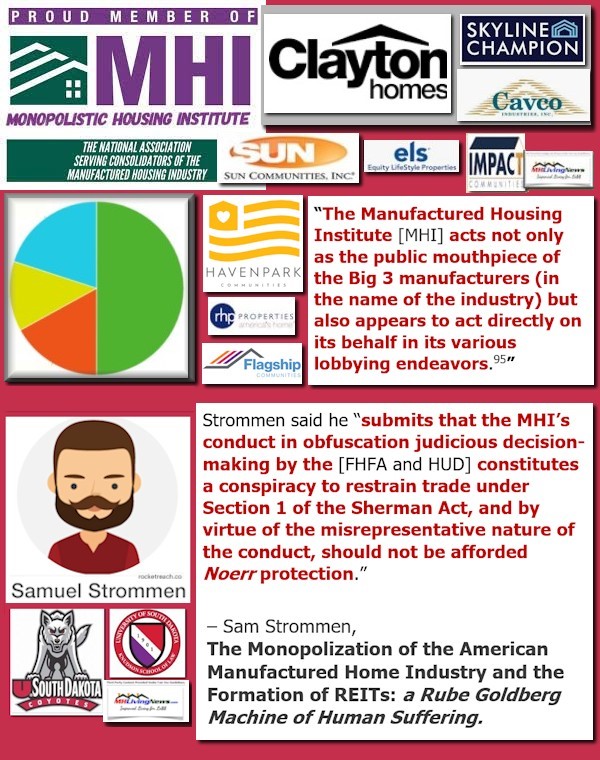


- Layton also missed mention of the Manufactured Housing Association for Regulatory Reform (MHARR). There is an evidence-based case to be made that no manufactured home trade association has invested more time and effort at exposing the zoning and financing challenges that are the bottlenecks for manufactured housing. MHARR has also invested

2) Layton said the following, quoted in Part I above.
“As background, it is worth remembering that housing has long been highly politicized, which is not surprising when government plays such a major role in it,10 including providing large overt and covert subsidies. Unfortunately, MH is no exception to this politicization, as in my view the published materials and research I have read – dozens of articles from housing policy organizations, academic and industry sources, popular printed and online media, and even YouTube videos – often reveal a strong advocacy approach, i.e. arguing in support of just one side of an issue, in this case to push for pro-MH government subsidies, regulations, or administrative actions.”
Layton has a point. But another missing fact is that despite Americans having a generally higher earning per household than many European and other nations around the world, there are nevertheless reportedly over 40 countries that have a higher rate of homeownership than the U.S. does. Those zoning, finance, and other barriers are having a genuinely negative impact on affordable home ownership that Layton should acknowledge by admitting that failure to enforce the 2000 Reform Law and HERA’s Duty to Serve have kept affordable home ownership at low ebb in the 21st century.

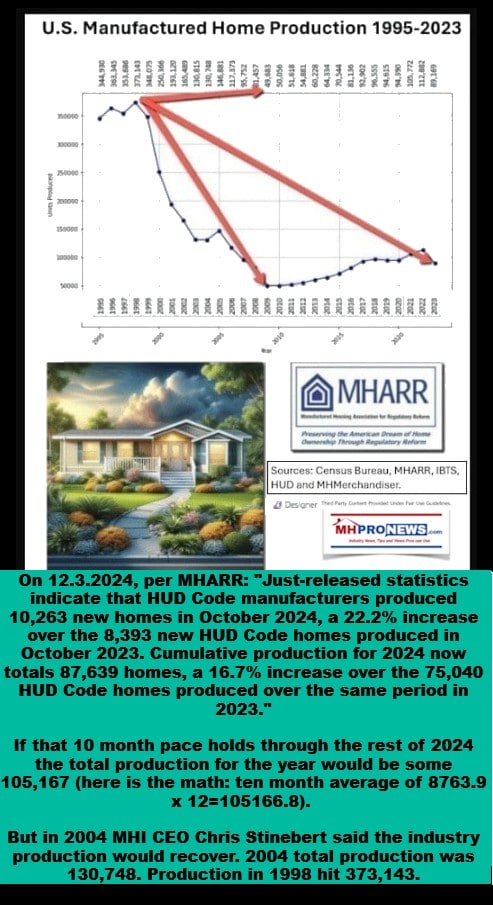
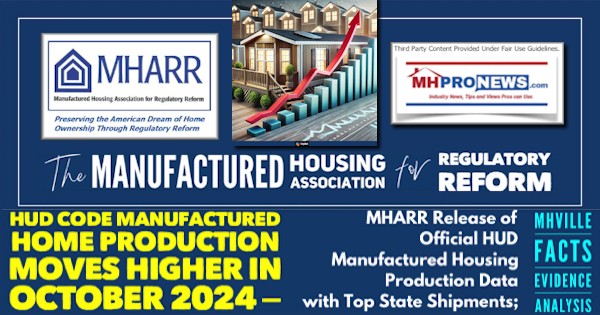
3) When Layton said that other sources “often reveal a strong advocacy approach, i.e. arguing in support of just one side of an issue, in this case to push for pro-MH government subsidies, regulations, or administrative actions” he is saying that bias and incomplete arguments exist in the world of manufactured home advocacy. Of course. But ironically, or worse, Layton is guilty of the same thing, isn’t he? By cherry picking who he cited and who he omitted, he failed to mention the two resources that are arguably the leaders in examining information from across the political, media, research, governmental, and other possible source spectrums. For example, by MHLivingNews sharing Layton’s Part I in toto, readers can see for themselves precisely what Layton said, and what he didn’t say that may be relevant to the discussion. Layton ignored the sources – examples: MHLivingNews and MHProNews – that disprove that part of his contention.
4) Someone can use the search tools on MHProNews and MHLivingNews to see precisely why Congress made DTS part of federal law. Someone can also see why failure to enforce DTS has contributed to the sharply lower percentage of home ownership that currently exists in the world of manufactured housing. See, for more information, the third-party research collection linked below along with articles shown as examples.

5) Congressional research into manufactured housing was another miss by Layton. More on that in a manner that explains why enhanced preemption and the Manufactured Housing Improvement Act of 2000 are so important is found below.



6) Layton wrote: “This article aims to take a fresh look at MH to determine just how much it truly can be a large-scale natural source of additional affordable housing, whether owner-occupied or rental, as claimed by its supporters in the industry and policy community.” The very last footnote by Layton said this:
“[25] A recent example of this was in California, where the state overrode local zoning to permit “in-fill” development, e.g., adding an accessory dwelling unit. The Biden administration’s policy announcement also was dominated by this in-fill approach.”
He is quite correct in pointing that out. But another word for “overrode” local zoning is to “preempt” local zoning. That was a key part of the 2000 Reform Law. Let’s close on this note, because the references that follow are a reasonably good sampling from an array of sources that say in their own words why federal preemption is so critical to creating more manufactured homes, and thus ease the affordable housing crisis, often without a need for subsidies.



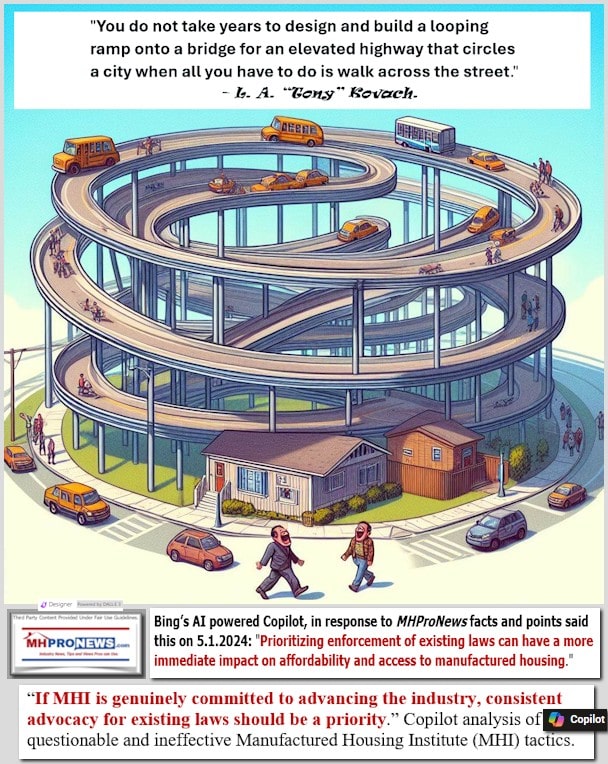
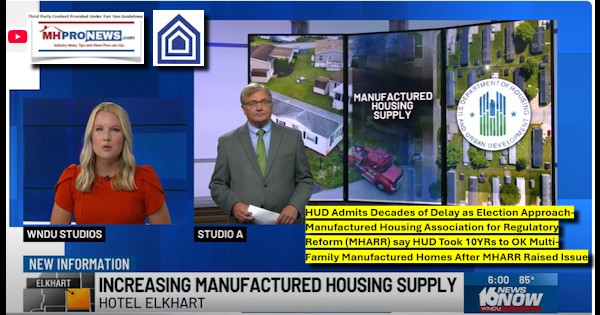





Mobile Home and Manufactured Home Living News explores the good, bad, and ugly realities that keep the most proven form of affordable home ownership under-appreciated and misunderstood. MHLivingNews provides third-party research and other resource collections and reports not found on other sites. We also provide thought provoking analysis that are designed to open minds and hearts. This is the widely acknowledged best source for authentic news on mobile and manufactured home living, as well as the policies that impact this segment of housing that provides 22 million Americans with good, surprisingly appealing living.
On our MHProNews sister-site and here on MHLivingNews, we lay out the facts and insights that others can’t or won’t do. That’s what makes our sister site and this location the runaway leaders for authentic information about affordable housing in general, the politics behind the problems, and manufactured homes specifically.
That’s a wrap on this installment of “News through the lens of manufactured homes and factory-built housing” © where “We Provide, You Decide.” © ## (Affordable housing, manufactured homes, reports, fact-checks, analysis, and commentary. Third-party images or content are provided under fair use guidelines for media.) (See Related Reports, further below. Text/image boxes often are hot-linked to other reports that can be access by clicking on them.)

By L.A. “Tony” Kovach – for MHLivingNews.com.
Tony earned a journalism scholarship and earned numerous awards in history and in manufactured housing. For example, he earned the prestigious Lottinville Award in history from the University of Oklahoma, where he studied history and business management. He’s a managing member and co-founder of LifeStyle Factory Homes, LLC, the parent company to MHProNews, and MHLivingNews.com. This article reflects the LLC’s and/or the writer’s position, and may or may not reflect the views of sponsors or supporters.
Connect on LinkedIn: http://www.linkedin.com/in/latonykovach
Recent and Related Reports:
The text/image boxes below are linked to other reports, which can be accessed by clicking on them.

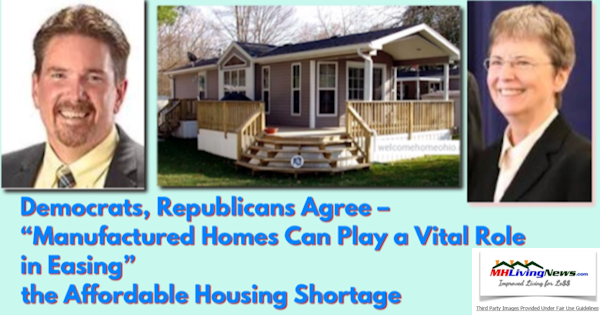
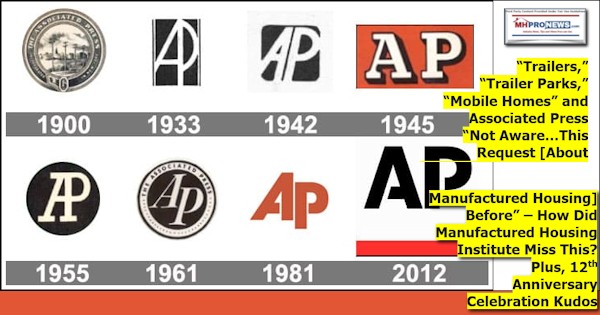 https://www.manufacturedhomepronews.com/masthead/trailers-trailer-parks-mobile-homes-and-associated-press-not-awarethis-request-about-manufactured-housing-before-how-did-manufactured-housin
https://www.manufacturedhomepronews.com/masthead/trailers-trailer-parks-mobile-homes-and-associated-press-not-awarethis-request-about-manufactured-housing-before-how-did-manufactured-housin
 manufacturedhomelivingnews.com Manufactured Home Living News
manufacturedhomelivingnews.com Manufactured Home Living News







































